Since it started in New York City in 1969, following the so-called Stonewall Rebellion, the Gay Pride March has paraded around the world in spaces and among bodies that cling to both heterosexual and homophobic desires. What took place on that momentous night of June 27, 1969 at the Stonewall Inn was inevitable. Gays trooped to the bar that night to make a customary toast to mark the death of gay icon Judy Garland (Fredericks, n.d.). Predictably, the police decided to flex their masculine presence against the homosexual customers. After stating their “usual homophobic comments,” the police started throwing out the customers (Batie, n.d.). Such police action was an attempt to protect the city from homosexual “encroachment” as much as the gays’ protests and dissents were attempts to thwart homophobic elements from entering their space. Stonewall Inn, after all, was a gay bar. This incident would have probably remained closeted had the participants decided not to draw the public’s attention toward it. Although it was generally reported as a “spontaneous reaction against police harassment,” the behaviour of those who were there suggested the opposite:
Instead of quietly slipping away into the night, as we had done for years, hustlers, drag queens, students, and other patrons held their ground and fought back. Someone uprooted a parking meter and used it to barricade the door. The agents and police were trapped inside. They wrecked the place and called in reinforcements. Their vehicles raced to the scene with lights glaring and sirens blaring. The crowd grew. Someone set a fire. More people came. For three days, people protested. And for the first time, after innumerable years of oppression, the chant, Gay Power, rang out (Batie, n.d.).
Since then, public assertion of Gay Power, which had been assembled through the Gay Pride March, has been calculated to provoke and goad the public from seeing what it would rather not see. It has become a force that is both epistemologically and visually arresting. Visually and spectacularly transgressive, images and ideas displayed during the Gay Pride March are also indicative of the contradictions, exclusions, and marginalisation apparent within and outside the lesbian, gay, bisexual, and transgender (LGBT) movement. There seems to be an apparent tendency to valorise, rather than transform, the heteronormal regime (particularly in cities where Gay Pride Marches are held) that continues to demonise, discipline, and regulate the homosexuals.
Where are the lesbians?
In 1994 in New York, the organisers of the International Dyke March, called the Lesbian Avengers, brought to the attention of the Gay and Lesbian Alliance Against Defamation (GLAAD) the “lack of mainstream press coverage of the Dyke March.” The Lesbian Avenger’s complaint was also about the extensive press coverage of the Gay Games, which took place as the Dyke March was proceeding. The New York Times allotted nine lines to the Dyke March. The New York Times had been honoured by GLAAD for “outstanding press coverage of Stonewall history, culture and events.” But because of the paltry press coverage of the Dyke March, the Lesbian Avengers “requested GLAAD to retract its top honours to the New York Times, and for GLAAD to pressure New York-based media to improve lesbian coverage” (Branner, 1994).
In Manila in 2004, the tenth anniversary of the LGBT pride in the Philippines was celebrated as part of the Gay Pride March. A local newspaper covered this event, which was participated in by those who call themselves LGBT. The Manila Times (December 12, 2004), however, decided to print an interview of a male gay who blamed the Philippines’s “bankrupt economy and disgusting human rights situation as contributing to the sad state of affairs of the LGBT community.” Another local newspaper adopted the same treatment of giving prominence to gays in its coverage of the 2003 Gay Pride March. The Philippine Daily Inquirer (July 2, 2003) featured a male gay and some names of gays. Moreover, it described the marching crowd as thus: “gays and straight mixed and matched on the street…students, yuppie types, bar and partyphiles, fashionistas, cross-dressers, fag nets, and fag stags were all there to be counted.” There was no mention at all of the lesbians or their more popular designations like tomboy or t-bird.
These incidents simply foreground an already acknowledged situation among lesbians: their invisibility even in the so-called LGBT community. Richard Norton situates lesbians within discourses on male homosexuality as being “usually presented as an appendage to gay history…almost every theory about homosexuality is essentially a theory about male homosexuals” (Norton, 2003).
Media could not apparently distinguish between a gay and a lesbian. Nothing better illustrates this than the cover of Time magazine of Ellen DeGeneres (April 14, 1997) with the caption “Yep, I’m Gay.” In a similar move, the Washington Post and the New York Times “ran an all-male photo of the April Gay Pride March on Washington with captions about gay men and lesbians” (Graff, 1993).
The invisibility of lesbians
There is a popular assumption that the Gay Pride March encompasses all homosexuals and their ever-expanding appellations: gays, lesbians, bisexuals, transgenders, intersexuals, and queers. But it has already been noted that people tend to associate gays with men. Usage of the phrase “gays and lesbians,” which the media deploys blindly, has created a situation where lesbians are erased by not mentioning them at all. Media assumes that when gay issues are covered, lesbian issues have been accordingly brought in (Graff,1993).
Contrary to the popular perception (among those who remonstrate against the invisibility of homosexuals in mainstream media), homosexuals have always been visible in the media. Media has already shifted from projecting homosexuals as purveyors of perversity to being “newsworthy” for the controversy and spectacle that they provide to a news report. Media has discovered that gays and lesbians could be packaged as consumable items as in news reports. Gays and lesbians have become “lucrative advertising market, which translates into increased coverage of their issues.” This, however, does not automatically include lesbians because “only those with disposable income are likely to be covered, and they are more likely to be gay men” (Cherata, 1994).
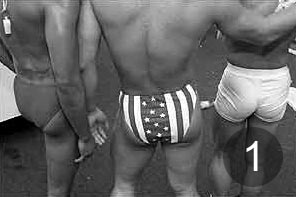 An attempt to clarify the unprofitability of the lesbians, which translates to their invisibility, has been advanced by Lee and Dow (2001). They noted that “lesbians seem to occupy the peculiar metaphysical status of the omitted, that is, inferable yet invisible.” They attributed this observation to the difficulty of locating lesbians inside the realm of the rational: as lesbians, they are symbolically positioned as below the norms of heterosexuality. The stereotype that lesbians are mannish and masculine symbolically positioned them as being above women just like men. It is in this situation of indeterminacy of lesbians that the media has projected them in the Gay Pride March.
An attempt to clarify the unprofitability of the lesbians, which translates to their invisibility, has been advanced by Lee and Dow (2001). They noted that “lesbians seem to occupy the peculiar metaphysical status of the omitted, that is, inferable yet invisible.” They attributed this observation to the difficulty of locating lesbians inside the realm of the rational: as lesbians, they are symbolically positioned as below the norms of heterosexuality. The stereotype that lesbians are mannish and masculine symbolically positioned them as being above women just like men. It is in this situation of indeterminacy of lesbians that the media has projected them in the Gay Pride March.Politics of media in the Gay Pride March
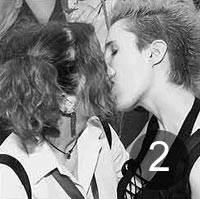 Just like homosexuals, media corporations have been stereotyped as performing communicative and informative functions. But one must bear in mind that this function is a one-way street; news, for instance, is consumed passively—one can simply sit or lie down while reading, watching, or listening to media broadcast. There is also always a strident call to protect and maintain press freedom, and to spare media from censorship and other controlling measures so much so that one overlooks the fact that the media is the most repressive of them all. As is well known, not all make it to the news, and news are just that: what a newspaper or reporter decides what should be news. Once the media reports a story or event—and usually it does not make this story or event happen—it becomes the media’s event or story.
Just like homosexuals, media corporations have been stereotyped as performing communicative and informative functions. But one must bear in mind that this function is a one-way street; news, for instance, is consumed passively—one can simply sit or lie down while reading, watching, or listening to media broadcast. There is also always a strident call to protect and maintain press freedom, and to spare media from censorship and other controlling measures so much so that one overlooks the fact that the media is the most repressive of them all. As is well known, not all make it to the news, and news are just that: what a newspaper or reporter decides what should be news. Once the media reports a story or event—and usually it does not make this story or event happen—it becomes the media’s event or story.  On BBC News, the 2003 Gay Pride March in London has become a party. Some of the photos of the March uploaded on its website are captioned as “London’s Gay Pride March…chance to dress up and party”(Photo 1); “After the parade, the party continues in Hyde Park” (Photo 2). Threats, disruptions, and instabilities that were presumably the purpose of the Gay Pride March have been stabilised; its festive and celebratory atmosphere maintained but within the confines of a socially approved gathering like a party.
On BBC News, the 2003 Gay Pride March in London has become a party. Some of the photos of the March uploaded on its website are captioned as “London’s Gay Pride March…chance to dress up and party”(Photo 1); “After the parade, the party continues in Hyde Park” (Photo 2). Threats, disruptions, and instabilities that were presumably the purpose of the Gay Pride March have been stabilised; its festive and celebratory atmosphere maintained but within the confines of a socially approved gathering like a party. In the 2004 Gay Pride March, CBS News decided to caption its photos of the participants as “a person carrying a flag” (in Panama City, Photo 3), “a participant making a gesture” (in Mexico City, Photo 4), “a gay pride supporter” (in Atlanta, Photo 5), “two men walking hand-in-hand” (in Paris, Photo 6), and “people marching during Gay Pride” (in El Salvador, Photo 7). As the LGBT communities around the world marched to the beat of “we” in the 2004’s March, a “fictive we” was likewise created by the media network within the same event. Any extra-ordinariness of the flamboyant and outrageous costumes that had been worn by participants to the March were edited out by the media by designating the
In the 2004 Gay Pride March, CBS News decided to caption its photos of the participants as “a person carrying a flag” (in Panama City, Photo 3), “a participant making a gesture” (in Mexico City, Photo 4), “a gay pride supporter” (in Atlanta, Photo 5), “two men walking hand-in-hand” (in Paris, Photo 6), and “people marching during Gay Pride” (in El Salvador, Photo 7). As the LGBT communities around the world marched to the beat of “we” in the 2004’s March, a “fictive we” was likewise created by the media network within the same event. Any extra-ordinariness of the flamboyant and outrageous costumes that had been worn by participants to the March were edited out by the media by designating the 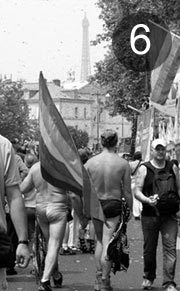 participants as people, supporter, participant, men, or person. By doing so, CBS News successfully addressed itself to both the LGBT and its “straight” audience: neither is likely to be offended.
participants as people, supporter, participant, men, or person. By doing so, CBS News successfully addressed itself to both the LGBT and its “straight” audience: neither is likely to be offended. The BBC had captured in photos the actual people who participated in the 2002 Gay Pride March and designated to them the following terms: “flamboyant costumes were the order of the day” (Paris, Photo 8), “crowd was in a party mood” (Israel, Photo 9), “some had clearly put real effort into their outfits” (unidentified location, Photo 10). The only explicit use of lesbians/gays was the Manila celebration, a photo of which was captioned “gays and lesbians in Manila staged a rally calling for an end to discrimination (Photo 11),” even while the photo had suggested the same flamboyance-of-a-crowd-in-a-party-mood.
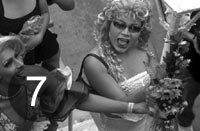 Such depiction, apparently true to the colours and carnivalesque ambience of the Gay Pride March, serves the double purpose of stimulating the senses while freezing reason in linking the March with social changes. What is thereby highlighted is the notion of self-gratification (flamboyant costumes of a crowd in a party mood) rather than self-determination. In the present social order, individualistic tendencies (like self-gratification) are privileged over assertion of autonomy and personal agency (like self-determination). This is not news but promotion of normal and acceptable ways of behaving publicly—packaged as news.
Such depiction, apparently true to the colours and carnivalesque ambience of the Gay Pride March, serves the double purpose of stimulating the senses while freezing reason in linking the March with social changes. What is thereby highlighted is the notion of self-gratification (flamboyant costumes of a crowd in a party mood) rather than self-determination. In the present social order, individualistic tendencies (like self-gratification) are privileged over assertion of autonomy and personal agency (like self-determination). This is not news but promotion of normal and acceptable ways of behaving publicly—packaged as news.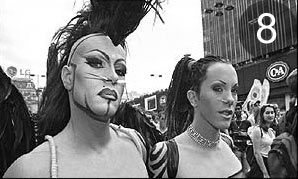 Politics of the Gay Pride March in the media
Politics of the Gay Pride March in the mediaThe rainbow coloured Pride flag has also become a flag for other pride, especially for the city where the March is usually held. For instance, according to the website of BBC News, London Mayor Ken Livingstone, who had attended the festival, said: “I am proud that London continues to lead the way in moving towards lesbian and gay equality...” The website of ABC News in Australia reports from the city of Port Phillip: “The mayor has backed police plans to join in this weekend’s Gay Pride March…the decision to march in uniform simply reflects diversity in the community… it is not pandering to minorities or causes but a celebration of diversity and a show of tolerance by the police force.” Well-conveyed by the mayor—participation by the police was not about being sympathetic to the concerns of the homosexuals but about public or media display of its kindness and tolerance toward an otherwise intolerable group of people.
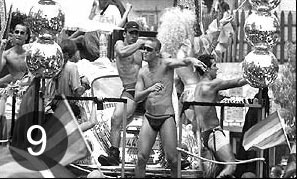
Apparently, media could also extend the same degree of tolerance even to those who are against homosexuals, like the late Pope John Paul II’s condemnation of the “Gay Pride March” in Rome. On the same day in which the BBC covered the 2000 March, it directed readers to its website news item dated January 13, 1998: “Serial killer suspected of murdering Italian gays.” The media can conveniently justify this by invoking the dictum of balanced news reporting. Indeed, gay politics is being balanced by homophobic assaults.
The implication is so palpable that BBC did not waste a single word of explanation as to the relevance of an old news item to a freshly covered event. After all, homophobic
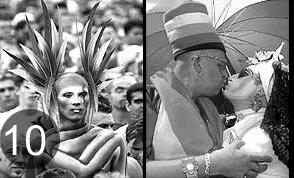 attitudes and assaults are so well-known that they are no longer news. But, still, why would the BBC put it as a news item if not to warn gays of what awaits them? But more than this, of course, is the BBC’s attempt to use all of its communicative and informative power to solicit consent from the public that killing gays is justifiable because of who they are. One must notice that the murder was not identified by its sexual orientation—it is simply but dubiously a serial killer.
attitudes and assaults are so well-known that they are no longer news. But, still, why would the BBC put it as a news item if not to warn gays of what awaits them? But more than this, of course, is the BBC’s attempt to use all of its communicative and informative power to solicit consent from the public that killing gays is justifiable because of who they are. One must notice that the murder was not identified by its sexual orientation—it is simply but dubiously a serial killer.N-o-w-here, finally, are the lesbians?
It appears that the media is predisposed to nominally mentioning the lesbians in its coverage that tends to bear headings like “Police Attend Gay Festival,” “Boston
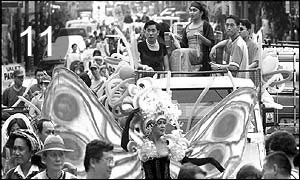 Parade Celebrates Gay Pride,” “City Set for Gay Pride Festival,” “Got Pride?” “Pro Gay Scores Government Rights Record.” Equally gaining media mileage are the legislative reforms that are bannered in “Gay Pride Marches,” the most prominent of which is the marriage reform and equality status being sought by certain segments of the LGBT community. Again, the media approach is to append and conflate the lesbians with gays, projecting them as a gay couple or simply a couple. This is a tendency that has already been noted: the heterosexualisation of the homosexuals. Under media’s scopic regime, the lesbians have been re-signified as a male (gay). Visibly neither male nor female, media has decided that the lesbians are one of the guys in the “Gay Pride March.”
Parade Celebrates Gay Pride,” “City Set for Gay Pride Festival,” “Got Pride?” “Pro Gay Scores Government Rights Record.” Equally gaining media mileage are the legislative reforms that are bannered in “Gay Pride Marches,” the most prominent of which is the marriage reform and equality status being sought by certain segments of the LGBT community. Again, the media approach is to append and conflate the lesbians with gays, projecting them as a gay couple or simply a couple. This is a tendency that has already been noted: the heterosexualisation of the homosexuals. Under media’s scopic regime, the lesbians have been re-signified as a male (gay). Visibly neither male nor female, media has decided that the lesbians are one of the guys in the “Gay Pride March.”It would be far too easy to argue that this is simply a case of misrepresenting the lesbians. Another convenient explanation is that it is a case of expressing media’s homophobia. This is a re-invented sense of moral order. The media is trying to make the Gay Pride March less offensive and less dangerous by depriving lesbian women the media (e)scape that would spare the public from seeing them in full view. By doing so, the media has managed to re-orient the prevailing heteronormal order that obliquely condemns all homosexuals (without offending them) but allows the public to gaze at them (also without offending them).
In the meantime, the media has re-inserted itself as a neutral, objective, and disinterested “conveyor belt” of social events like the Gay Pride March. But, maybe, it is not a conveyor belt but it is more like it is mediating prevailing norms and moral order. This is what lesbian politics in the media is all about—to annihilate them. To rephrase Monique Wittig’s assertion in her novel Les Guerilleres:
The language media speaks is made up of words that are killing the lesbian. It is impossible, of course, to annihilate the lesbians, so media has resurrected ‘mankind’ that was much maligned by feminists because of its commanding power to be understood as also including ‘women.’ Subsumed under gays, lesbians have become gays, hence we must not allow the term ‘gay’ to retrieve the persuasive power that previously enthroned ‘mankind’.
References
Batie, A. (n.d.). The history of the Stonewall rebellion. Retrieved February 13, 2005, from <gender.eserver.org/stonewall-history.txt>.
Branner, A. (1994). There was a Dyke March? In Off our backs. Retrieved February 13, 2005, from <www.findarticles.com/p/articles/mi_qa3693/is_199408/ai_n8710868/pg_2>.
Cheratra, Y. (1994). Gays in the news. Retrieved February 13, 2006, from <www.peak.sfu.ca/gopher/94-2/issue1/gaynews.ans>.
Fredericks, K. (n.d.). The spirit of Stonewall. Retrieved February 13, 2006, from <www.greenleft.org.au/back/1993/104/104p11.htm>.
Graff, E.J. (1993). Not a ladies auxiliary: Media coverage of gays neglects lesbian. The Progressive. Retrieved February 13, 2006, from <www.findarticles.com/p/articles/mi_m1295/is_n10_v57/ai_13290559>.
Lee, W. L. & Dow, Laura M. (2001). Queering ecological feminism: Erotophobia, commodification, art and lesbian identity. Ethics and the Environment, Vol. 6, No. 2.
Norton, R. (2003). The nature of lesbian history. Retrieved February 13, 2005, from <www.infopt.demon.co.uk/lesbians.htm>.
Portions of this paper were presented at the “1st International Conference of Asian Queer Studies: Sexualities, Genders and Rights in Asia,” July 7-9, 2005, Bangkok, Thailand.





 The
The 
 Isis Resource Center holds one of the largest feminist collections of materials in the Global South. With 40 years of publication experience, Isis holds a vast collection.
Isis Resource Center holds one of the largest feminist collections of materials in the Global South. With 40 years of publication experience, Isis holds a vast collection.